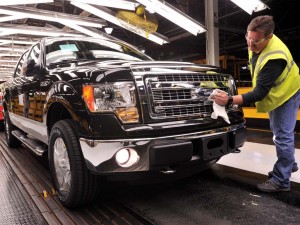Toyota surged into second place in the U.S. auto market last month, slipping past perennial second-place maker Ford Motor Co. with a 16.5% jump in July sales.
By comparison, Ford gained a more modest 11% in volume year-over-year, well behind the overall surge in the rebounding U.S. market. But the maker insists it would have done significantly better if it simply had the capacity to keep up. Ford dealers report they’re struggling to meet demand for the maker’s full-size F-Series pickups. And Ford is not alone.
While Chrysler reported an 11% gain for July – its 40th consecutive monthly increase in demand – the maker’s Jeep brand was one of the few marques to suffer a sales decline. That’s largely the result of the slow ramp-up of Chrysler’s Toledo assembly plant which has been shuttered for months as it prepares for the roll-out of the new Jeep Cherokee model.
“They’re being held back by capacity constraints,” said Dave Sullivan, Detroit-based auto analyst with consulting firm AutoPacific, Inc., noting that the domestic makers are “slowly adding capacity back after taking so much out during the recession.”
Chrysler CEO Sergio Marchionne now says he hopes to never have to completely idle a plant during a model changeover again. In the meantime, the maker is struggling to get the Toledo plant up to speed with sales of the new ute expected to begin in little more than a month.
Ford, meanwhile, is taking several steps to resolve its production shortfalls. The most immediate is the addition of a third shift at its pickup plant in Kansas City, Missouri. The move will require another 900 hourly workers – good news for an economy where most job growth has been in the low-wage and part-time categories. For Ford, that could add up to several thousand more F-Series pickups a week.
Better yet, it will further enhance capacity utilization, a fancy way of saying it requires little fixed cost investments since the maker will be able to utilize existing plant tooling.
Detroit automakers have been reluctant to invest in new factories after emerging from a recession that forced them to close scores of parts and assembly plants across North America – for Ford, that included F-Series pickup lines in Virginia and in Canada.
Going into the Great Recession, some of their facilities were operating below 50% capacity, a guaranteed way to lose money. Today, however, many domestic auto plants are already operating at well above 100% of straight-time, two-shift capacity, forcing manufacturers to look at their options if they don’t want to hand business to their competitors.
There are potential issues with going the three-shift route, which analyst Sullivan calls “a pretty significant thing to do.” It means adding a lot of new manpower that involves a lot of training up front while there could be hefty cost penalties later if demand cools and Ford has to drop a shift.
But is certainly less expensive than building a new plant – and gets production going a lot more quickly. Ford is adding some brick-and-mortar, however, with a $1.1 billion expansion of the Missouri plant underway. When completed, the maker will add yet another 2,000 jobs to handle production of the new Transit commercial van.
Along with the Kansas City facility, Ford also plans to add production of its hot-selling Fusion sedan at a factory in Flat Rock, Michigan, just south of Detroit. That facility was run as a joint venture between Ford and Mazda until last year, when the Asian maker pulled out and shifted assembly of its Mazda6 sedan back to Japan. Ford is also planning to increase production of the compact Escape crossover-utility vehicle.
General Motors has also been struggling to meet capacity for some of its key models, investing in some plant expansion programs where necessary, adding shifts at other facilities.
And the Detroit makers aren’t the only ones struggling to deal with capacity constraints as the U.S. market recovers from its worst downturn in more than half a century. Sales last month worked out to an annualized rate of 15.8 million compared to the 14.5 million new vehicles sold in the United States last year.
Among the brands facing the toughest challenge are Korean siblings Hyundai and Kia. John Krafcik, CEO of Hyundai Motor America recently warned that even though the maker will almost certainly set a new sales record this year it will likely lose market share because it doesn’t have the capacity to keep up with the overall pace of the American market recovery. Hyundai and Kia officials are now looking at ways to expand operations at their plants in Alabama and Georgia, respectively.
Complicating matters for auto manufacturers like Ford and Hyundai, “There’s also capacity issues with suppliers,” cautions analyst Sullivan. Like their customers, auto parts makers slashed both production and excess capacity during the recession and now are struggling to keep up with demand. That’s a bottleneck that could constrain automotive assembly plants for several years to come, industry observers warn.


Unfortunately the new jobs created now will be eliminated in a few years once the market is once again saturated with 2-3 new leased vehicles in every driveway.